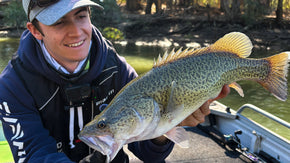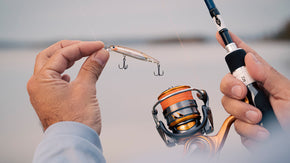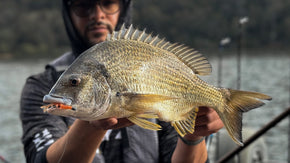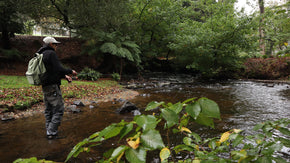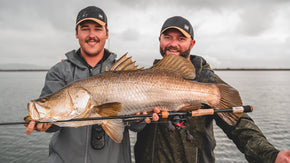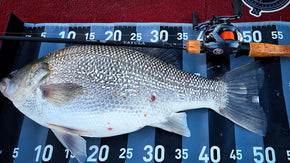Posted 30th September 2022
How to Catch Giant Trevally on the Great Barrier Reef


By Tammy Spina
Watching giant trevally crushing lures off the surface while surrounded by beautiful reef is one of my favourite things in the world. Giant trevally or GT are one of those fish that almost every angler must experience and tick off their bucket list.
For me GT are something I use to dream of when I was young and now that I live in Townsville chasing these amazing fish has becoming a bit of an addiction. GT are very powerful, aggressive, at times acrobatic, visually stunning and even vocal with deep grunting sounds when landed, and offer a great test for your angling skills, your gear and your fitness level.
Learning all about the species I am targeting is something I’m very passionate about. I love ticking off goals and better yet once I have ticked off my own goals I love being able to share what I have learnt through my experience and help others with similar passions achieve their goals and share in the joy and excitement together. I hope from this article you can gain some insights that will have you better prepared to tackle the mighty Giant Trevally and land that dream fish.
Tackle Talk
GT fishing starts with being prepared, the right quality gear and the best knots are needed to have a positive experience. Casting and working heavy lures on a large rod and reel all day can be extremely physical and taxing and you still need the energy and strength to actually fight and land the fish which is why I generally have two casting set ups to choose from.
If you are new to this style of fishing or lack a bit of physical strength than I would recommend a PE4-6 rod with a 10K size reel and PE#5 braid. A lighter combo will be less taxing if casting all day but will limit the weight and size of the lure you can throw, and you will struggle if those fish start pushing into the 20kg mark.
For my lighter setups I run a 20 Salitst Hyper S76-4/6 with a 10k 21 Saltist MQ or 21 Demon Blood s77-4/6 with a 10k 21 Certate SW both are running PE#5 Saltiga 12 braid as it gives me a better breaking strain for its diameter which also assists in making casting easier and a 120lb leader. With a cast weight of 35-100gm these combos also double as my flats setups and work great for other species like Spanish mackerel making them a great purchase for anyone getting into their reef lure fishing.
 Heavy Tackle
Heavy Tackle
For my heavier setups and these are my go-to setups for GT, I run a 21 Demon blood S80-6/8 with a 14k 21 Certate SW and a Spartan S80-6/8 with a 14k Saltiga both spooled with PE#6 Saltiga 12 Braid and I will normally use 120-150lb leader. With a casting weight of 80-180gm and drag power of 25kgs these rods and reels are the perfect GT Combos for me. They offer great casting distance and solid backbone with enough stopping power for most reef GT and the quality gear keeps the weight down making for a much more enjoyable experience.
Along with quality rod, reel and line I highly recommend a couple of accessories that are pretty much a must have on your GT adventures.
Firstly, a good pair of casting gloves is needed as the braided lines and heavy lures can make a mess of your casting finger. It may feel strange at first and take some getting used to but these also come in handy when landing the fish as you can wrap the line around one hand and lift the tail with the other. Please note GT have very sharp tail scoots that can easily cut you so please use a glove or towel when handling by the tail.
A light fishing belt or foam butt to hold the butt of your rod when you are hooked up is never a bad idea and is a must have when fighting bigger fish to save you from getting bruised up from the pressure you have to put on these fish during the fight.
A quality heavy duty pair of split ring pliers is worth investing in. Seriously save yourself a lot of fiddly work or knot tying and simply spilt ring your lure to a solid ring or swivel so you can change your lure in seconds.
Getting Lured
Speaking about lures, a big part of chasing GTs is the massive range of weird, wonderful and colourful lures to choose from. Obviously for me fishing topwater stickbaits are my go-to, there is nothing better than watching what looks like a hand grenade go off as a GT explodes on your surface lure. At times GT will pretty much take anything you throw at them; on other days they seem to have a favourite. Poppers are a great lure to use as they create a big splash which will bring the fish in from further away, however these lures can be harder to work and are more taxing on the body.
Wind chop and strong current might make you consider going to a sinking stickbait if you find your surface lure is struggling, pulling out of the water and tumbling.
Finding a good stickbait or popper that is easy for you to cast and use or suits the conditions is a matter of personal preference but anything in the 150- 220mm and 60-120gm size are ideal. For me I’ve had a lot of success using the Daiwa 220F Saltiga Dive Star and the Nashys Custom lures 180mm floating stickbait.
If the lures you purchase have existing hooks and split rings make sure they are strong enough. If in doubt you can’t go wrong changing your terminals to BKK. If you hook that dream fish you don’t want to ruin your chances of landing that fish due to weak terminal tackle that’s just not built for the job. Trust me it’s a necessity.
Also, I personally crush all barbs on my reef gear making removal of the hooks not only easier but also safer for me!
Where Are They
Now that we got all our gear sorted you simply head to the reef, throw a surface lure and a GT will immediately come out and crush it right? I mean it’s the Great Barrier Reef GT are everywhere… right? Well there is a little more to it than that.
First tip is not to fish reef “walls”, if you can find the isolated bommies holding schools of fusiliers on the edge of the reef then you’ve got a good chance of finding a GT.
To find the bommies open google earth or similar apps and have a look at the reef you are wanting to fish, this will give you a greater understanding of which way your reef is facing and where your pressure points will be depending which tide you are fishing and/or which way the current is flowing. You will also see bommies and patches of reef on these maps you can use this as a guide for where you want to start looking.
Search for clusters of bommies in separations of the reef, this can cause water to push through a particular area of the reef and hopefully bait will be holding in these areas.
Chasing the Tide
What tide are you fishing? Run in or run out? The great thing about GT is they can be caught on both tides however the tide will determine where you want to start looking for ground to fish. You generally want to fish the side of the reef that is getting the most pressure building up against it. If the tide or current is coming from the south then you want to start at the southern side of the reef.
Once you’re there searching you don’t want to spoil the areas too much by driving over the bommies so slow down and stay back and keeping your eyes peeled for fusiliers as most the time they will tell you where the bommies are before you get to them. If you can identify where the fusies are holding before driving over the area your chances of hooking fish go up dramatically.
Fusies if being harassed by predatory fish will create a fizzing, bubbling motion or even spray on the water surface. This is a lot easier to see if you are heading out on a calm day, but can still be seen in average conditions if you have a good eye for it or know your reef well.
Once located and a well-placed long cast has been made, quickly take up the slack in your line because if the GT are hungry they will hit the lure as soon as it lands, so be ready. If you've taken up your slack line and you haven't had a hit start with a few short sweeps and a pause. If there's still no response continue to work the lure right back to the boat. If no success, try again and try to mix up your retrieve, but be careful burning lures back to the boat as Spanish mackerel have been known to become airborne and torpedo threw the air towards anglers.
Time to Strike....actually don't!
Try not to strike at the sight of the topwater explosion of the GT as you will pull the lure away from the fish, rather wait till you feel the load up of the rod, then set the hooks with a few short jabs. Make sure drag is set prior to your cast, too tight and you might lose your grip, too loose and you won’t be able to set the hooks and keep the GT from getting his head in the reef, then bye bye lure. For me a good way to test if your drag is correctly set is to crank up the drag then see if you pull any line off. Once you get it to the point that you can pull any line off, crank it up a little bit more and you should then be ready to go.
So you got all the gear, you punch in that perfect cast, a GT grenade has gone off and you have yourself a little tug-a-war and land that fish. The excitement is through the roof, everyone’s super stoked, just remember amongst all the excitement, thrills and photos that you look after the fish. Try to avoid placing the fish on hot surfaces and get it back in the water as fast as you can.
That’s a good place to get you started. Like any type of fishing, time out on the water is where you learn the most so enjoy the journey of learning all you can till the magic happens.
Till the next blog guys, HAPPY FISHING!









